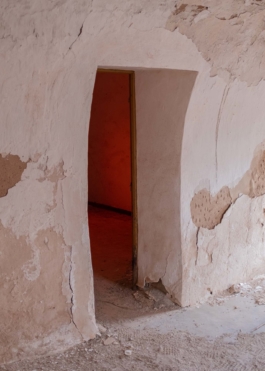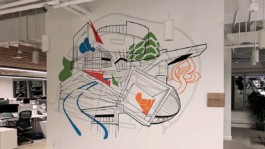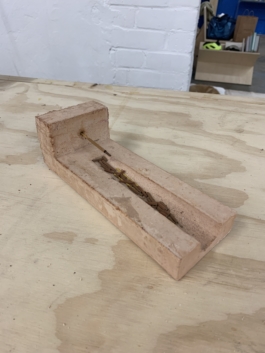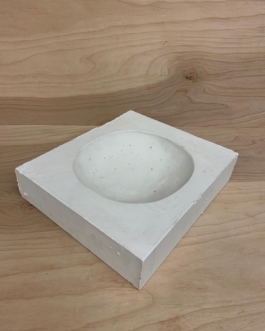Notice: A change is proposed
February 23 – March 12, 2023
Project 107, Toronto
an exhibition by Nicole Charles and Justin Pape
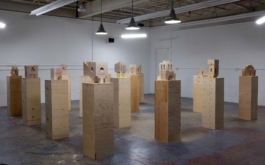
Commuting across the city of Toronto, one can notice its changing landscape – construction is a constant and cranes dress the horizon. As of 2022, Toronto was home to 252 active cranes (dwarfing the 203 active cranes across the United States), and the majority of these were used for new builds rather than retrofitting older structures. According to heritage architect Catherine Nasmith, “it takes about 50 years of energy savings to pay down the debt to the environment created by the creation and transportation of construction materials”. On top of that, only 12% of waste from construction sites is diverted from landfill. The remaining 88% overwhelms landfills and accounts for 20–30% of the total municipal landfill in Ontario. A frightening prospect is that Ontario is expected to exceed its landfill capacity by 2032.
This building, 7 Labatt Ave, has lived a life longer than most of Toronto’s inhabitants. Over 110 years it has morphed with its tenants and now, it's slated for demolition. This exhibition is an ode to the building and others like it, an exploration of the impact of construction in this city and the value we place on overlooked and discarded things. What would Toronto look like if we opted to retrofit buildings before demolishing them? How could our value system shift to appreciate the unique heritage of the city?
The artifacts in this exhibition are cast with a mixture of 50–75% collected debris from construction sites around Toronto, including famous landmarks, ignored structures and Victorian houses. The binding component of the mixture is gypsum based, which is a material commonly used in the construction of drywall, plaster and sometimes cement. The molds used to cast the structures were created from offcut insulation boards salvaged from construction sites and their shapes often dictate the final form of the sculpture. Architectural and abstract in their form, they could live in centuries past or future, in an imagined city built on the foundation of its past and quietly carrying its hidden histories within its walls.


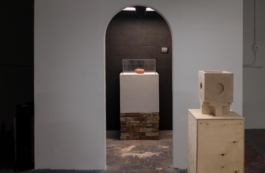
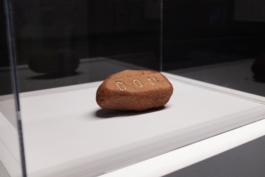



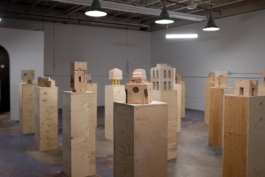
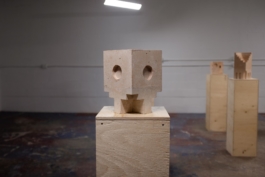


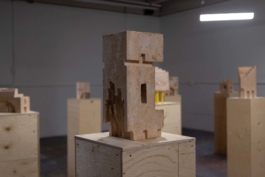



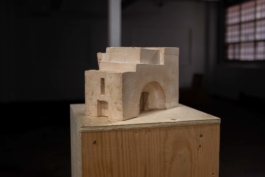

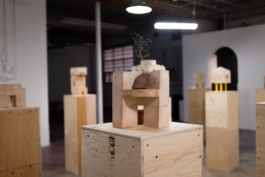


*The following details about 7 Labatt Ave and its history are based on information which was collected and compiled between March 2020–February 2023.
In the early 1900s, the land on which 7 Labatt Ave (formerly Radenhurst St) stands was housing. The business and manufacturing on this street began with a manufacturer of metallic conduit and interior decorations at 33 Labatt Ave. By the early 1910s, the housing was gone and a building was erected which spanned plots 11–21 Labatt Ave. (This building was the original structure of the current 7 Labatt Ave). At the time the original structure was built, the John Labatt Brewing Company had expanded its operations to Toronto and this building was the site of one of its bottling plants.
By 1917, the building had expanded from plots 11–21 to 7–21. In 1917, the Crouse-Hinds Company, manufacturers of electrical specialities, signed a lease with John Labatt Limited to rent plots 7–21 for $458.33 per month. Crouse-Hinds left the building in the mid 1960s, making them one of the longest term tenants of the building’s history. In the 1920s, the company specialized in industrial lighting and traffic signals and in 1925, they manufactured and installed Toronto’s first traffic light at Yonge and Bloor. Their diecast and green enamel explosion proof lights were manufactured in this building, are used to light a portion of this exhibition and can still be found in various halls and units of this building.
According to research and records, 7 Labatt Ave was vacant from 1992–1994. Presumably this was for renovation to launch 7 Labatt Place in 1995, a community of professional, business-minded individuals.
In 2013, Labatt Urban Village was announced to replace the current building. It would be a 413 foot-high building atop an 11 storey podium.


This exhibition was subsequently presented at the Ontario Science Centre as part of the Architectural Conservancy Ontario's annual symposium.
The Science Centre was designed by Japanese-Canadian architect Raymond Moriyama and, as of this exhibition in September 2023, it was in a state of limbo due to the Ontario government's proposed plan to demolish it (more on this).
The building is integrated into the hills of the Don Valley ravine. It sits 6 km north of the Don Valley Brickworks where most of the bricks used in this project were made in the early 20th century.






Process photos taken by Vanessa Heins:

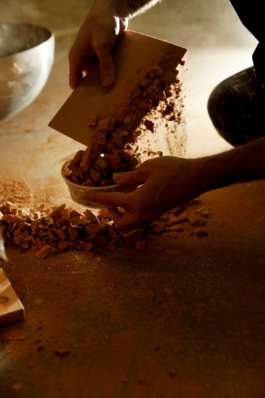







Notice: A change is proposed
February 23 – March 12, 2023
Project 107, Toronto
an exhibition by Nicole Charles and Justin Pape

Commuting across the city of Toronto, one can notice its changing landscape – construction is a constant and cranes dress the horizon. As of 2022, Toronto was home to 252 active cranes (dwarfing the 203 active cranes across the United States), and the majority of these were used for new builds rather than retrofitting older structures. According to heritage architect Catherine Nasmith, “it takes about 50 years of energy savings to pay down the debt to the environment created by the creation and transportation of construction materials”. On top of that, only 12% of waste from construction sites is diverted from landfill. The remaining 88% overwhelms landfills and accounts for 20–30% of the total municipal landfill in Ontario. A frightening prospect is that Ontario is expected to exceed its landfill capacity by 2032.
This building, 7 Labatt Ave, has lived a life longer than most of Toronto’s inhabitants. Over 110 years it has morphed with its tenants and now, it's slated for demolition. This exhibition is an ode to the building and others like it, an exploration of the impact of construction in this city and the value we place on overlooked and discarded things. What would Toronto look like if we opted to retrofit buildings before demolishing them? How could our value system shift to appreciate the unique heritage of the city?
The artifacts in this exhibition are cast with a mixture of 50–75% collected debris from construction sites around Toronto, including famous landmarks, ignored structures and Victorian houses. The binding component of the mixture is gypsum based, which is a material commonly used in the construction of drywall, plaster and sometimes cement. The molds used to cast the structures were created from offcut insulation boards salvaged from construction sites and their shapes often dictate the final form of the sculpture. Architectural and abstract in their form, they could live in centuries past or future, in an imagined city built on the foundation of its past and quietly carrying its hidden histories within its walls.




















*The following details about 7 Labatt Ave and its history are based on information which was collected and compiled between March 2020–February 2023.
In the early 1900s, the land on which 7 Labatt Ave (formerly Radenhurst St) stands was housing. The business and manufacturing on this street began with a manufacturer of metallic conduit and interior decorations at 33 Labatt Ave. By the early 1910s, the housing was gone and a building was erected which spanned plots 11–21 Labatt Ave. (This building was the original structure of the current 7 Labatt Ave). At the time the original structure was built, the John Labatt Brewing Company had expanded its operations to Toronto and this building was the site of one of its bottling plants.
By 1917, the building had expanded from plots 11–21 to 7–21. In 1917, the Crouse-Hinds Company, manufacturers of electrical specialities, signed a lease with John Labatt Limited to rent plots 7–21 for $458.33 per month. Crouse-Hinds left the building in the mid 1960s, making them one of the longest term tenants of the building’s history. In the 1920s, the company specialized in industrial lighting and traffic signals and in 1925, they manufactured and installed Toronto’s first traffic light at Yonge and Bloor. Their diecast and green enamel explosion proof lights were manufactured in this building, are used to light a portion of this exhibition and can still be found in various halls and units of this building.
According to research and records, 7 Labatt Ave was vacant from 1992–1994. Presumably this was for renovation to launch 7 Labatt Place in 1995, a community of professional, business-minded individuals.
In 2013, Labatt Urban Village was announced to replace the current building. It would be a 413 foot-high building atop an 11 storey podium.


This exhibition was subsequently presented at the Ontario Science Centre as part of the Architectural Conservancy Ontario's annual symposium.
The Science Centre was designed by Japanese-Canadian architect Raymond Moriyama and, as of this exhibition in September 2023, it was in a state of limbo due to the Ontario government's proposed plan to demolish it (more on this).
The building is integrated into the hills of the Don Valley ravine. It sits 6 km north of the Don Valley Brickworks where most of the bricks used in this project were made in the early 20th century.






Process photos taken by Vanessa Heins:









Info >
Nicole is a Canadian interdisciplinary artist, designer, actor, curator and co-founder of Project 107 + PACHlab. She is motivated by curiosity, problem solving and story telling and is currently based in Toronto, Canada.
Contact
nicoledcharles [@] gmail.com
CV, Press
Select Projects >
Exhibitions
Notice: A change is proposed

















Info >
Nicole is a Canadian interdisciplinary artist, designer, actor, curator and co-founder of Project 107 + PACHlab. She is motivated by curiosity, problem solving and story telling and is currently based in Toronto, Canada.
Contact
nicoledcharles [@] gmail.com
CV, Press
Select Projects >
Exhibitions
Notice: A change is proposed

